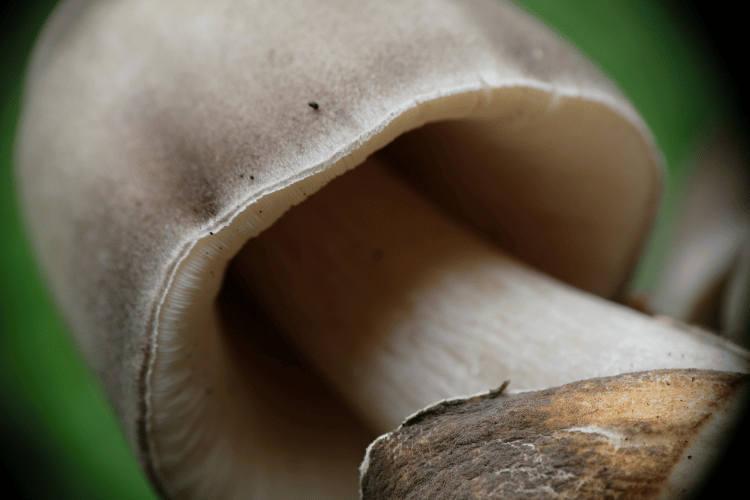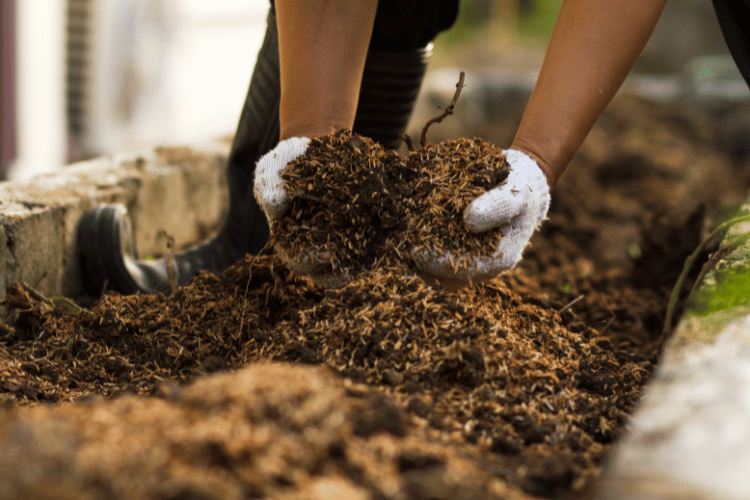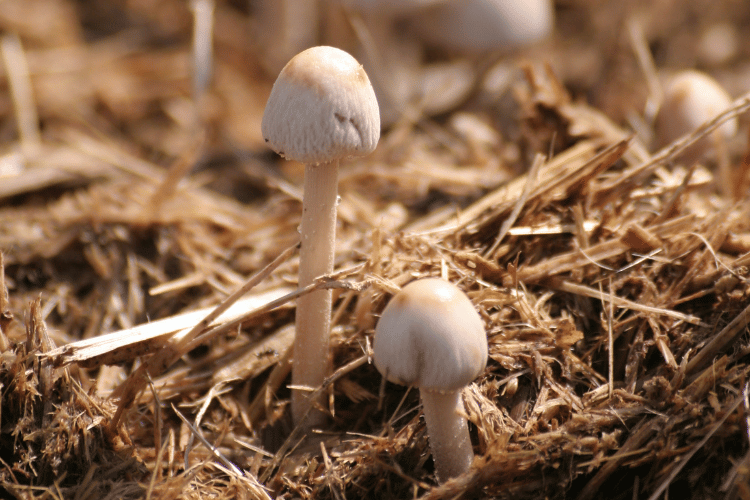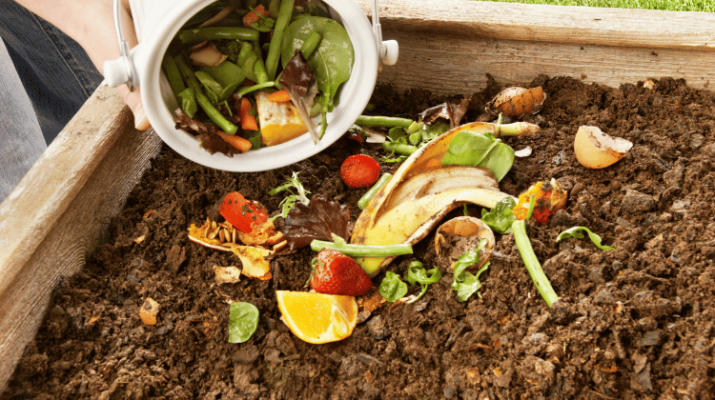A while ago, we discussed the best worms for raised garden beds. But maybe your soil mixture needs something extra.
In this case, mushroom compost might be the answer.
Today, we’ll check out the benefits and drawbacks of using mushroom compost in raised beds. We’ll also talk about how to incorporate worms into the equation.
But first, let’s take a look at what this type of compost is all about!
Mushroom Compost: Explained

The term “mushroom compost” might lead you to believe it’s a product derived directly from mushrooms, but the reality is a bit different.
Rather than being made from mushrooms, the compost is a byproduct of large-scale mushroom farming. It’s the soil-like material left behind after harvesting the crop.
So, it would be more accurate to call it “spent mushroom substrate” or “spent mushroom compost.” Let’s call it SMS or SMC for convenience’s sake.
But don’t let the “spent” part of the name fool you into thinking it’s all depleted and useless. It’s still rich in organic matter, making it an excellent soil conditioner!
Before we move on to the pros and cons, let’s check out the components.
The exact “recipe” varies from grower to grower, but the SMC will likely contain a handful of the following stuff:
- Gypsum
- Wheat straw
- Horse manure (or chicken manure)
- Cottonseed or cocoa bean hulls
- Corn cobs
It’s worth noting that farmers could steam the leftover substrate to eliminate pests and pathogens. Plus, some mushroom growers use pesticides during the crop cycle, while others avoid chemical pesticides altogether.
The Advantages of Using Mushroom Compost in Raised Beds
If you’re using a raised bed, odds are, your native soil quality is poor and needs a boost.
Much like regular compost, SMC is also a sort of “black gold.” So, let’s see what SMC can do for you:
Adds Plant Nutrients
Mushroom soil compost serves as a rich source of both macronutrients and micronutrients. It supplies phosphorus and potassium, along with calcium, magnesium, and iron.
Sure, it might have a slightly low nitrogen content—the plant’s leafy obsession—but that can be a good thing sometimes. Avoiding excessively high nitrogen levels can nudge your plants to focus on flowers and fruit.
Improves Soil Structure and Water-Holding Capacity
One of the standout features of this spent compost is its high organic material. That’s why it can hold water like a champ!
Not only does it give your plants a hydration boost, but it also creates a vibrant ecosystem for microbial activity.
SMC can also save you some hassle if you’re battling dense clay soil. With its straw content, it swoops in to break up the clay, promoting better drainage.
Plus, as it fully decomposes, it leaves behind a crumbly texture, a sure sign of improved soil structure.
Worms Don’t Hate It
Now, you’re probably wondering: But would SMC kill the worms in my soil?
Well, that’s not likely. After all, some folks use fresh mushroom compost as a cozy bedding in their worm farms. So, a bit of aged compost in your raised bed won’t hurt the little wigglers!
The trick here is to understand how steam pasteurization treatment might affect the organisms in the substrate. If it’s been steamed, it’s better to let it sit outside for a while to get worm-friendly again.
The Drawbacks of Using Mushroom Compost in Raised Beds
Now, let’s shed some light on the not-so-shiny aspects of mushroom compost.
Content and Quality Might Vary
As we’ve mentioned earlier, different mushroom growers use different blends, which makes the substrate a bit unpredictable in terms of nutrient content.
You also need to be wary of the sort of manure the growers use. Do they use manure sourced from antibiotic-fed chickens? If so, traces of antibiotic-resistant bacteria might linger in the final compost, which is far from ideal.
Chock-full of Soluble Salts
SMC can be heavy-handed with soluble salts, potentially causing trouble for germinating seeds, delicate seedlings, and salt-sensitive plants like camellias and blueberry bushes.
Many mushroom growers will age the compost first before selling it. But don’t worry if you find yourself with a batch of fresh compost. Just buy it early on (fall or winter) and let it leach out with the rain.
Unfortunately, the high soluble salt levels aren’t just a nuisance for salt-sensitive crops. That’s because SMC brings more calcium to the garden party than regular compost, thanks to all that gypsum.
Now, the calcium salts can be beneficial for tomato vegetable crops. But they can also be a headache for acid-loving plants like azaleas and rhododendrons.
Needs to Be Mixed With Soil
Many compost types perform better when mixed with regular soil.
After all, straight compost might compact too tightly, lack a balanced nutrient profile, and even contain too much salt. Don’t forget that introducing it to your garden soil helps it acclimate to beneficial microbes as well.
That’s why many folks use only a tiny bit of compost with no less than 50% garden soil in their raised beds. Think of the compost as a soil conditioner or amendment agent.
Some people choose to go with nearly 100% mushroom compost mix in their beds. Still, we recommend that you experiment cautiously if this is your first run with the calcium-rich SMC.
Incorporating Worms for a Dynamic Garden Ecosystem

Now that we’ve explored the pros and cons of SMC, we can check out the practical side.
The compost is quite versatile. It can serve as a soil amendment, substitute for mulch, or even function as a slow-release fertilizer with low heavy metal content and high soluble salt concentrations.
For now, we need to focus on using it in raised beds and maximizing its benefits with the help of our wriggly allies for now!
When to Use Mushroom Compost
For best results, use aged SMC around the spring and summer when the soil is relatively dry. This way, you won’t run into compaction issues.
Preparing the Raised Beds and Applying the Compost
Traditional methods involve digging the compost or scraps into the soil trenches via single or double-digging techniques. But to cut the hassle, you can opt for a no-dig approach.
Instead of disrupting the existing soil structure, just spread a thin layer of mushroom compost (only a few inches thick) over the main soil in the raised bed. Easy peasy!
How well does it get mixed into the bulk of the soil, you ask? Well, soil organisms, especially worms, will do all the heavy lifting for you.
Using a blend of organic mushroom compost and compost worms in the raised bed can help with this aspect.
Insights Into Vermicomposting Mushroom Compost
If you’re venturing into vermicomposting as a way of recycling spent compost, be aware that the worm-based composting process can significantly alter the medium’s characteristics.
The wigglers might reduce the C:N ratio, pH levels, total organic carbon, and electric conductivity.
Mushroom Compost Recipe for a Raised Bed

Okay. So, you need to use coarse sand and garden soil with the SMC. That sounds good enough, but creating the perfect blend for your raised beds requires more than just that.
Here are some ideas for customizing your mushroom compost recipe:
- Lucerne
- Blood and bone
- Compost tea
- Regular compost
The goal is to expedite compost breakdown, infuse it with nutrient-rich elements, and reintroduce microorganisms. You can even dig kitchen scraps into a trench in the raised bed for added organic material goodness!
Mushroom Compost vs. Vermicompost: Which Is Better?
Choosing between mushroom compost and vermicompost boils down to personal preference. But let’s check out two factors that can help you decide.
Content
The chemical composition in both vermicompost and spent mushroom compost can change based on the starting materials and feed type.
Before we compare it to vermicompost, we should check out a general comparison between two types of mushroom compost:
| Content (by % dry weight) | Fresh SMC | Aged SMC (16 months) |
| Calcium | 3.63–5.15 | 6.27 |
| Total Nitrogen | 1.42–2.05 | 2.72 |
| Potassium | 1.93–2.58 | 0.43 |
| Phosphorus | 0.45–0.69 | 0.84 |
With this in mind, we can say that weathered SMC has an average NPK ratio of 2.7:0.8:0.4. Meanwhile, the pH is around 7.1.
To put things into perspective, you can expect an NPK of 5:3:3 from your humus-rich worm castings.
Convenience
Mushroom compost is available in bulk and requires less hands-on management.
On the other hand, vermicomposting is an eco-friendly endeavor, contributing to waste reduction. The catch here is you need to wait a lot of time before the worm castings are ready for harvest.
Final Thoughts
To sum up, using mushroom compost for raised-bed gardening can be a double-edged sword.
On the bright side, it enhances water retention, adds vital soil nutrients, and accommodates friendly worms in your raised beds. However, the variable quality and high soluble salt content warrant caution.
Ultimately, the choice will depend on what you’re planning to do with the raised bed later on. You might be better off using a more acidic soil mixture in some cases.

